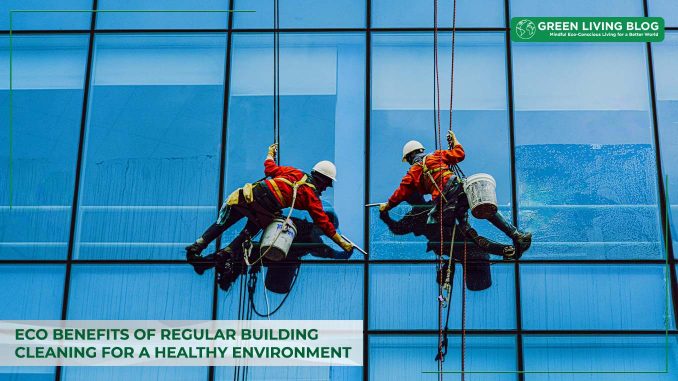
Maintaining a clean environment is essential for the well-being of building occupants and the longevity of the building itself.
Regular building cleaning goes beyond aesthetic appeal; it significantly impacts health, productivity, and overall environmental quality.
This article delves into the multifaceted benefits of regular building cleaning and how it contributes to a healthy environment.
1. Enhancing Indoor Air Quality

Indoor air quality (IAQ) is a critical factor in ensuring the health of building occupants. Dust, allergens, mold, and other pollutants can accumulate over time, leading to respiratory problems, allergies, and other health issues.
Regular cleaning helps to minimize these contaminants. Dusting, vacuuming, and air duct cleaning are vital practices that reduce the presence of allergens and improve IAQ. By removing dust and particulate matter, regular cleaning also prevents the buildup of potentially harmful substances, ensuring a healthier breathing environment.
2. Preventing the Spread of Germs and Bacteria
High-touch surfaces such as door handles, elevator buttons, and communal areas are breeding grounds for germs and bacteria. In commercial and residential buildings alike, regular disinfection is essential to prevent the spread of infectious diseases.
Routine cleaning protocols, especially in high-traffic areas, can significantly reduce the risk of illnesses. During flu seasons or pandemics, intensified cleaning efforts are crucial to safeguard the health of occupants. Implementing regular cleaning schedules ensures that surfaces are consistently sanitized, reducing the likelihood of disease transmission.
3. Prolonging the Life of Building Materials

Building maintenance is not only about cleanliness but also about preserving the structural integrity of the property. Regular cleaning prevents the deterioration of building materials caused by dirt, grime, and pollutants. For instance, carpets and flooring can wear out faster if not cleaned regularly, leading to expensive replacements.
Similarly, neglecting window cleaning can result in permanent damage due to the corrosive effects of pollutants and hard water. Regular cleaning helps maintain the aesthetic and functional aspects of building materials, ultimately saving costs on repairs and replacements.
4. Enhancing Aesthetic Appeal
A clean building creates a positive impression on visitors, clients, and potential tenants. The aesthetic appeal of a building can influence perceptions and decisions, making regular cleaning a valuable investment. For businesses, a well-maintained environment reflects professionalism and attention to detail. In residential settings, cleanliness enhances the quality of life and can even increase property values. Regular cleaning ensures that both the interior and exterior of the building remain visually appealing, fostering a welcoming atmosphere.
5. Boosting Employee Productivity and Morale

The cleanliness of a workplace has a direct impact on employee productivity and morale. A cluttered and dirty environment can be distracting and demotivating. In contrast, a clean and organized workspace promotes efficiency and boosts employee satisfaction.
Regular cleaning reduces clutter, minimizes the presence of allergens, and creates a pleasant working environment. Employees are more likely to feel valued and motivated when they work in a clean and well-maintained space. Additionally, a hygienic environment can reduce sick days, leading to increased productivity and overall business performance.
6. Environmental Considerations
Regular building cleaning also has environmental benefits when done using eco-friendly practices. Green cleaning products and methods reduce the impact of cleaning on the environment. Traditional cleaning products often contain harmful chemicals that can contribute to air and water pollution.
By adopting green cleaning practices, building owners can minimize their environmental footprint. Using biodegradable products, reducing water usage, and implementing recycling programs are steps that can enhance the sustainability of building cleaning efforts.
7. Implementing an Effective Cleaning Schedule
To reap the benefits of regular building cleaning, it is essential to implement an effective cleaning schedule. This involves identifying high-traffic areas, high-touch surfaces, and potential problem spots that require more frequent attention. Creating a cleaning checklist can help ensure that no area is overlooked.
Hiring professional cleaning services can also be beneficial, as they bring expertise and specialized equipment to the task. Professional cleaners can provide deep cleaning services that go beyond routine maintenance, addressing hard-to-reach areas and using advanced techniques to achieve optimal cleanliness.
8. The Role of Technology in Building Cleaning

Advancements in cleaning technology have revolutionized the way buildings are maintained. From robotic cleaners to automated systems, technology plays a significant role in enhancing cleaning efficiency and effectiveness. Robotic vacuums and floor cleaners can navigate large spaces and perform tasks with precision, reducing the workload on cleaning staff.
Automated air purifiers and HVAC systems with advanced filtration can continuously improve indoor air quality. Embracing these technologies can lead to more consistent and thorough cleaning outcomes, contributing to a healthier building environment.
Conclusion
In conclusion, regular building cleaning is paramount for maintaining a healthy environment. It enhances indoor air quality, prevents the spread of germs, prolongs the life of building materials, and boosts aesthetic appeal. Cleanliness also significantly impacts employee productivity and morale, underscoring its importance in commercial settings. Moreover, adopting eco-friendly cleaning practices can reduce the environmental impact of building maintenance.
By implementing effective cleaning schedules and leveraging advanced cleaning technologies, building owners can ensure that their properties remain clean, healthy, and inviting. Regular building cleaning is not merely a routine task; it is a vital component of building management that promotes health, sustainability, and overall well-being.
![]()
Author Profile
- Passionate content creator, contributor, freelance writer and content marketing allrounder.
Latest entries
 Green Home GuidesJune 9, 2025Sustainable Custom Wardrobes: Redefining Luxury with Eco-Conscious Craftsmanship
Green Home GuidesJune 9, 2025Sustainable Custom Wardrobes: Redefining Luxury with Eco-Conscious Craftsmanship Green LivingMay 21, 2025How Technology Is Helping Us Live Greener Lives
Green LivingMay 21, 2025How Technology Is Helping Us Live Greener Lives Best practicesMay 7, 2025Going Green: Simple Lifestyle Changes That Make a Big Impact
Best practicesMay 7, 2025Going Green: Simple Lifestyle Changes That Make a Big Impact BusinessApril 30, 2025Why forgotten Supplies can disrupt a sustainable Office Day
BusinessApril 30, 2025Why forgotten Supplies can disrupt a sustainable Office Day






Leave a Reply
You must be logged in to post a comment.